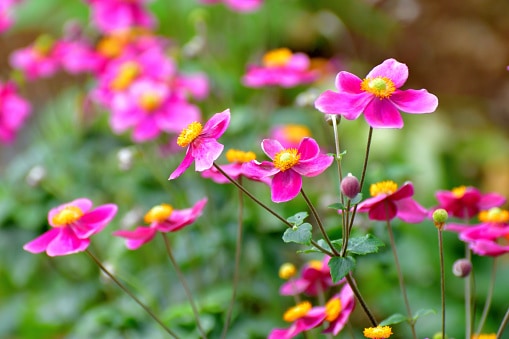This stunning flower is part of the Buttercup family, with a stunning display of double-deep, pink or white, cup-shaped flowers and intricate golden stamens in its center, providing an alluring appearance.
The etymology of Anemone hupehensis comes from the Ancient Greek myth of “Anemos” according to the myth, it was a white flower that sprang out of a tear, which was shed by Aphrodite, the goddess of love. This is a flower which is suitable for both indoor and outdoor potting, and which can help accentuate your garden with its luscious display of color.
How to Plant
Anemone hupehensis prefers either partial or direct sunlight, which should be at least 6 hours of direct sunlight in order to thrive. This flower is quite versatile and can survive in a range of different soils, but it is best to combine soil with organic matter and compost when planting. The pH levels should be kept between 6.5 and 8.0, and watering should be done regularly, taking the external conditions into account. Adding fertilizer during the blooming season will help maintain and improve growth.
Meaning and Symbolism
In ancient Greek literature, Anemone hupehensis was associated with the goddess of love, Aphrodite, as she was said to have shed her tears on the death of Adonis, when the flower sprouted from the ground. This flower is also seen as a representation of remembrance and anticipation, as its bloom enriches the transitional period between summer and fall.
History, Mythology, and Religious Significance
The flower’s great significance in Ancient Greek mythology has established it as a symbol of tragedy as well as love. Its extended bloom period and its beauty were appreciated for centuries, and it is today considered to be a much-valued flower among Japanese gardeners, who praise it for its elegance and grandeur.
The Bible also mentions anemones when referring to the tragic death of Adonis, a story in which Aphrodite is seen disconsolately weeping over her beloved, while anemones pour out of her tears. This story was used to illustrate the beauty of grief, which can be symbolically seen through the anemone’s five-petal structure.
Flower Varieties and Their Defining Characteristics
The Anemone hupehensis consists of several varieties, including the Japanese Anemone. Other varieties of this flower are the tuberous anemone, the Japanese windflower, and the de Caen Anemone. The Japanese Anemone is a perennial herbaceous flower, with white or pink petal-like sepals that form a cup-like shape, boasting a small fringe of yellow stamens in its center. The large-flowered variety, on the other hand, has the same five-part structure, albeit on a larger scale, with flatter segments that appear around August and Septembre.
How to Pot and Repot
The Japanese Anemone enjoys a well-drained, soil-based potting mix when it is kept indoors. Additionally, it’s important to select a pot which is just slightly larger than the previous one, as the roots need to be given room to expand. Regularly check the roots and trim them before the repotting process.
How to Prune
It is essential to prune Japanese Anemone following blooming in July, consequently promoting new growth and a healthy flower. Prune by removing spent stems, cutting back to the basal foliage. If a bush is getting too high, cut around a third of the stems back to the base, rejuvenating the plant.
How to Propagate
Propagation of Anemone hupehensis can be done by division. This process should be done in the fall, after the blooming period, when the roots can be safely divided. Additionally, all parts of the flower can be split, thereby allowing new plants to grow.
Common Pests and Diseases
The Japanese anemone is usually subject to several pests and diseases, including slugs, aphids, mildews, and rust. To prevent any occurrence, make sure to regulate watering, cover the soil with mulch, and avoid overcrowding. In case of problems with pests, it is advisable to apply biocontrol methods and chemical insecticides, after diagnosing the problem.
Three Frequently Asked Questions About Anemone Hupehensis
Q1: Where do Anemone hupehensis need to be planted in order to thrive?
A1: Anemone hupehensis plants prefer a sunny or partially sunny spot in the garden, with sufficient access to water.
Q2: How can pests and diseases be prevented?
A2: The best way to prevent such problems is to maintain healthy soil, keep plants away from overcrowding, use mulch to cover the soil, and regularly check the roots and stems. Additionally, biological control agents are recommended when dealing with pests, as well as specific chemical insecticides.
Q3: When is the best time for planting and repotting?
A3: The best time for planting Anemone hupehensis plants is in late spring, when conditions are optimal for their growth. For repotting, it is best to do this following blooming, when the roots are mature and can be safely divided, resulting in the creation of new plants.
Table Fact Sheet
| Plant Name | Japanese Anemone – Anemone hupehensis |
| Family | Ranunculaceae |
| Plant Type | Perennial |
| Mature Size | Up to 3 feet tall |
| Sun Exposure | Part sun or full sun |
| Soil Type | Organic, compost-enriched soil |
| Soil pH | 6.5 to 8.0 |
| Bloom Time | Late summer through to fall |
| Flower Color | White or pink |
| Hardiness Zones | 4–9 |
| Native Area | China, Japan, and Korea |
What we love from Amazon this week
Buy these wonderful flowers directly from Amazon:















